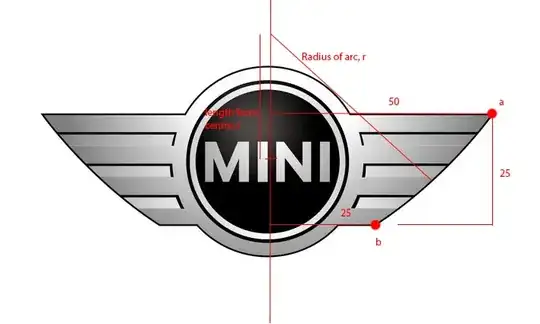The center point of a circular arc going through $A$ and $B$ will sit somewhere on a line $L$ that (1) bisects the line drawn from $A$ to $B$, which we'll call $\overline{AB}$, and (2) is perpendicular to $\overline{AB}$.
I'm assuming the center point of the drawing is, vertically, halfway between $A$ and $B$, and we'll make it our origin. Then we might assign $A$ the coordinates $(50, 12.5)$ and $B$ the coordinates $(25, -12.5)$. We see that their vertical separation is indeed $25$, because $12.5-(-12.5)=25$.
(1) $L$ bisecting $\overline{AB}$ means that $L$ passes through the midpoint of $\overline{AB}$. We can easily find the midpoint of $\overline{AB}$ by averaging the horizontal components and vertical components of $A$ and $B$. The midpoint is then $(\frac{50+25}{2}, \frac{12.5-12.5}{2}) = (37.5, 0)$.
(2) To make $L$ perpendicular to $\overline{AB}$ we first have to know the slope of $\overline{AB}$. The slope formula is $$m = \frac{y_b - y_a}{x_b - x_a} = \frac{12.5-(-12.5)}{50-25} = \frac{25}{25} = 1.$$ It is a neat property that, if $\overline{AB}$ has a slope $m$, every line perpendicular to $\overline{AB}$ will have a slope of $-\frac{1}{m}$. In this case, that's $-1$.
We now have everything we need to determine an equation for $L$. We'll write it in the form $y=nx+c$, where $n$ is the slope and $c$ is some constant. We know one $x,y$ pair—the midpoint—and we also know the slope, -1. So we just need to find $c$. $$0 = -1\times 37.5 + c$$ $$0 = -37.5 + c$$ $$37.5 = c$$ And now we have a nice equation for $L$: $y = -x + 37.5$
If the center of our arc is above the center of the drawing, we know its $x$ coordinate is 0. Since it's on the line $L$, it obeys the equation we just wrote, and we can use it to find the $y$ coordinate. $$y = -0 + 37.5 = 37.5$$ This is the "length from centre".
What is the radius? It is the distance from $(0, 37.5)$ to $A$ or $B$. We'll pick $A$, which we said was at $(50, 12.5)$. So we use the distance formula: $$d=\sqrt{(50-0)^2 + (12.5-37.5)^2}=\sqrt{50^2 + (-25)^2}=\sqrt{2500+625}=\sqrt{3125}\approx 55.9$$ To double check our work, we'll try $B$ as well. $$d=\sqrt{(25-0)^2 + (-12.5-37.5)^2}=\sqrt{25^2 + (-50)^2}=\sqrt{625+2500}=\sqrt{3125}\approx 55.9$$ This is "radius of arc".
